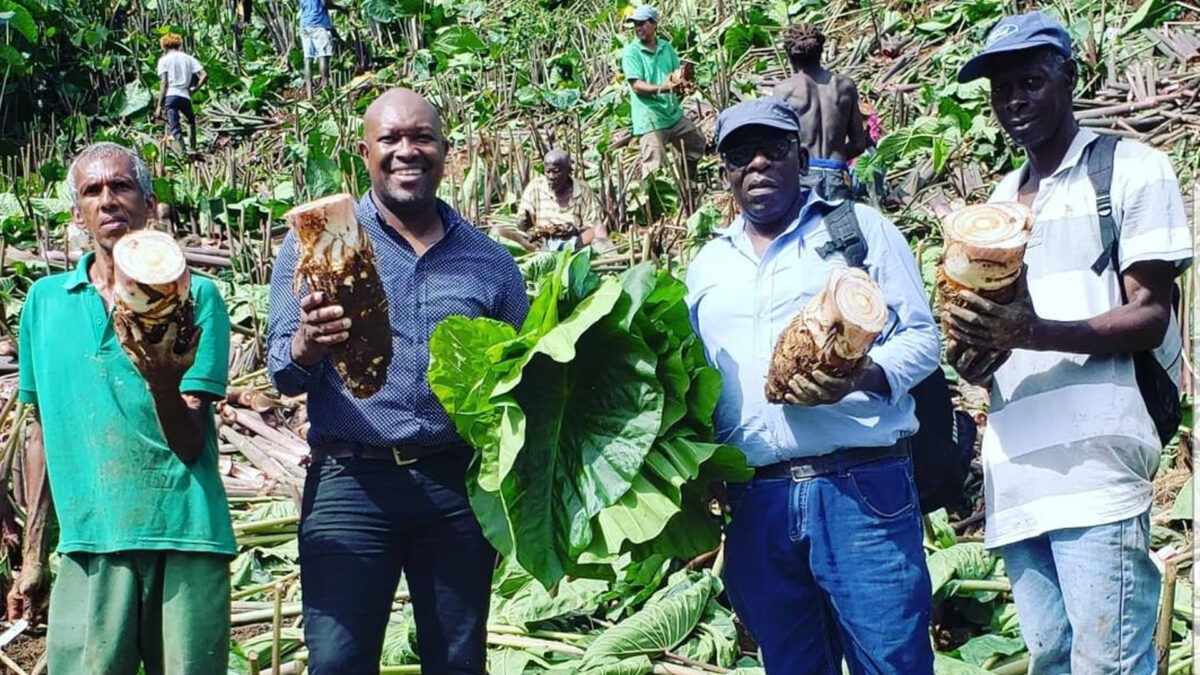Dasheen declared the ‘Blue Gold’ Crop of St Vincent and the Grenadines
Media Release courtesy St. Vincent Times
St. Vincent and the Grenadines was well known in the United Kingdom, for its “Green Gold” banana industry for over half a century, as a part of the Windward Islands banana platform. Grenada, St. Lucia, Dominica and St. Vincent and the Grenadines exported bananas weekly through WIBDECO/ WINFRESH and later the Fair Trade Organization.
Over the last two decades, St. Vincent and the Grenadines has advanced a diversification approach to agriculture, in the aftermath of the demise of the banana export industry caused by the removal of trade preferences.
Fast forward to today, the island has now declared a magical superfood – dasheen, as its future “Blue Gold.” Blue because most varieties of dasheen when cooked has a slightly blue colour.
There are several agri-ecological zones on the main island, St. Vincent that can produce dasheen throughout the year. The island’s rich volcanic soil and the recent ash eruptions of its volcano adds a unique flavour to the commodity which is sold as a premium tasting dasheen.
Over the past years, market entry into the United States of America, has encouraged many farmers to expand production. Dasheen is also currently exported to the UK and France. The regional market for dasheen is a major importer, with Trinidad and Tobago being the largest importer. The current thrust has a unique focus on import substitution, value addition and the introduction of modern technology to production.
Excerpt from Forbes Magazine:
“Dasheen Plant Could Be The Root Of Caribbean Development”
“From sauces, ice creams and liqueurs to pizzas, salads and soups, it is easy to make a variety of food items with the versatile tuber. The corm resembles a potato, which means that it can be fried, steamed, boiled, roasted or mashed and the leaves are reminiscent of spinach and can be boiled or steamed. The root can even be pulverised and converted into flour.
Dasheen has a higher nutritional value than most other roots and tubers and is said to have analgesic, anti-cancer and anti-inflammatory properties. The root is high in fibre, and is rich in vitamins and minerals such as Vitamin B6, C, E, potassium and manganese. The leaves are high in Vitamin A and C and both corms and leaves contain high-quality protein and are excellent sources of phosphorus, potassium, calcium, and iron.
From the perspective of farmers, dasheen is economically ideal. The crop requires few inputs but offers high rewards. As a high yielding crop, typical harvests of 12 to 14 tonnes per hectare can be expected when rainfall levels are high.
Globally, demand for the crop has increased by almost 12 per cent over the past few years, creating extra-regional opportunities for trade. (Taro Market – Growth, Trends, and Forecast (2020-2025)”) In countries such as Dominica, where 1,288 hectares are reserved for dasheen cultivation, with yields of more than 96,000 hg/ha, the crop is a critical export commodity. (FAOSTAT, 2018) In St. Vincent and the Grenadines, dasheen farming is omnipresent across the rural terrain, making it an important strategic commodity.
Dasheen’s ability to withstand extreme weather and support soil health and circular food culture makes it a beneficial crop for the environment; in its cultivation and production the crop has a little to no impact on water, land, forest, air or soil.
Dasheen is a herbaceous perennial that typically takes 7 to 12 months to fully mature. This means that the soil in which the crop grows can remain undisturbed for months before harvesting, which is good for maintaining high levels of soil carbon, promoting soil health and climate change mitigation.
Given that the entire plant, from leaves to roots, can be utilised in cooking, there is minimal post-harvest waste, which means that the plant carries a low carbon footprint and has great value from the perspective of food security.
Dasheen is also a climate resilient plant, with an ability to flourish during heavy floods. There are also varieties of the dasheen plant that are resistant to drought and high salinity soil.
In 2016, concerns surrounding the lack of genetic variety of dasheen in countries such as St. Vincent, Jamaica and Dominica resulted in the introduction of 50 new genotypes of the crop under a project funded by the EU. Continued support of this nature would be critical, in order to boost the biodiversity of the crop in the Caribbean, and enhance its climate resilience.
The Way Forward
Almost 5,000 miles away from the Caribbean, in Hawaii, dasheen or kalo as it is called, is regarded with utmost reverence. Referred to as “the staff of life”, it is used for medicinal purposes with the belief that it has the greatest life force of all foods. Dasheen is revered for its nutritional, environmental, economic and even spiritual properties.
Given its myriad benefits, the Caribbean has also begun to take notice.”
On February 7th, 2023, in the presence of over 250 dasheen stakeholders, the commodity was declared a main crop of St. Vincent and the Grenadines.
Hon. Saboto Caesar, Minister of Agriculture of St. Vincent and the Grenadines noted that over the next ninety days, stakeholders will be requested to confirm their investment space in the dasheen value chain. He added that the Ministry will be providing support for both producers and marketers. The Ministry will be working with other Windward islands to be able to address the issue of consolidated marketing.
Marcus Richards, Head of Agriculture Extension Services in St. Vincent and the Grenadines, noted that the shift to dasheen as such a prominent crop was “monumental”.
Donawa Jackson, a Senior Technical Officer in the Ministry of Agriculture presented the results of a survey conducted with a group of dasheen farmers revealing many opportunities for farmers.
The dasheen stakeholders of St. Vincent and the Grenadines are confident that the industry will be able to carve out a significant percentage of the global market share in the coming years.

